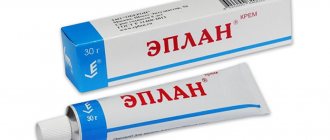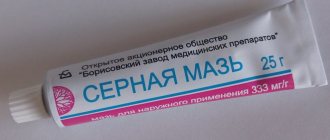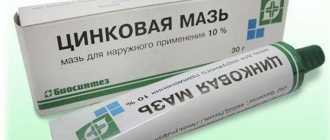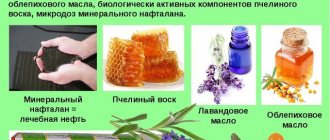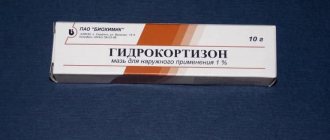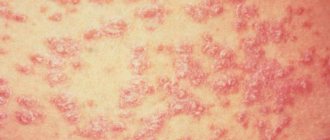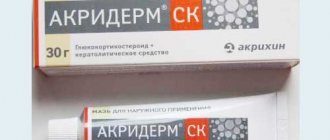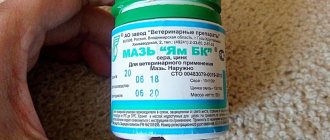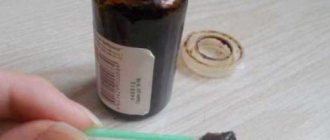To treat psoriasis, neurodermatitis, eczema and other skin diseases, various ointments are used, including those based on hydrocortisone. Such drugs include Lokoid cream. It has a quick effect and is safe for health. Suitable for both adults and children aged 6 months and older. You can buy the product at an affordable price and without a prescription.
Pharmacodynamics
Lokoid® is a synthetic non-halogenated corticosteroid for external use. Esterification of the hydrocortisone molecule with a butyric acid residue (butyrate) made it possible to radically increase the activity of the drug compared to native hydrocortisone. Lokoid® has a fast-onset anti-inflammatory, anti-edematous, and antipruritic effect.
The use of Lokoid® in recommended doses does not cause suppression of the hypothalamic-pituitary-adrenal system. Although the use of large doses of the drug for a long time, especially when using occlusive dressings, can lead to an increase in plasma cortisol levels, this is usually not accompanied by a decrease in the reactivity of the pituitary-adrenal axis, and drug withdrawal leads to a rapid normalization of cortisol production.
Use in pediatrics
The ointment can be prescribed to children from 6 months, but only under the supervision of a doctor. If the product is applied using occlusive dressings or on the skin of the face, the course of therapy should be reduced to a minimum. In this case, the maximum area of the treated cover should be less than 20% of the entire surface.
It should be noted that in children, adrenal suppression may manifest itself more quickly. A decrease in the synthesis of growth hormone is also often observed. If you use the ointment for a long time, it is important to monitor the child’s weight and monitor the concentration of cortisol in the blood, which is only possible with the participation of a doctor.
There is research data according to which children who received 7-8 g of ointment daily for a month did not experience side effects. The adrenal cortex worked normally in all those observed.
Pharmacokinetics
Suction
After application, the active substance accumulates in the epidermis, mainly in the granular layer; systemic absorption is negligible. A small amount of hydrocortisone 17-butyrate is absorbed into the systemic circulation unchanged.
Metabolism
The majority of hydrocortisone 17-butyrate is metabolized to hydrocortisone and other metabolites directly in the epidermis and subsequently in the liver.
Removal
Metabolites and a small part of unchanged hydrocortisone 17-butyrate are excreted by the kidneys and through the intestines.
Side effects of the drug Lokoid
local reactions (skin and subcutaneous tissue):
- skin atrophy (thinning of the epidermis, telangiectasia, purpura and striae);
- rosacea-like and perioral dermatitis;
- rebound effect, making corticosteroid withdrawal difficult;
- slower wound healing;
- effect on the eyes: increased intraocular pressure and the risk of developing cataracts (if the drug is systematically exposed to the conjunctiva);
- depigmentation, hypertrichosis;
- contact allergy.
Systemic effects . In adults, when GCS is used topically, they are very rare, but they can be serious. With prolonged use of the drug, suppression of the function of the adrenal cortex may occur.
Contraindications
hypersensitivity to hydrocortisone or auxiliary components of the drug;
bacterial skin infections (strepto- and staphyloderma, gram-negative folliculitis, etc.);
viral skin infections (herpes simplex, chicken pox, shingles, etc.);
fungal skin infections;
tuberculous and syphilitic skin lesions;
parasitic skin infections;
neoplastic skin changes (benign and malignant tumors);
acne, rosacea, perioral dermatitis;
post-vaccination period;
violation of the integrity of the skin (wounds, ulcers).
With caution: pregnancy, lactation period.
Contraindications to the use of the drug Lokoid
- dermatitis complicated by bacterial (pyoderma, syphilis and tuberculosis), viral (herpes, chickenpox, herpes zoster, genital warts, warts, molluscum contagiosum), fungal and parasitic infections;
- wounds and ulcerative skin lesions;
- perioral dermatitis; atrophic skin lesions;
- rosacea localized in the facial area; acne, ichthyosis, teenage plantar dermatosis, fragility of skin vessels;
- hypersensitivity to the components of the drug or to other corticosteroids;
- age up to 6 months.
Directions for use and doses
Externally. Lokoid® in the form of an ointment is used for subacute and chronic processes, especially in the presence of lichenification, infiltration, and dryness.
The drug is applied to the affected areas of the skin in a thin layer 1-3 times a day. If positive dynamics appear, the frequency of use of the drug can be reduced to 2-3 times a week. To improve penetration, the drug is applied with massaging movements. In cases of resistant disease, for example, when dense psoriatic plaques are localized on the elbows and knees, the drug can be used under occlusive dressings. The dose of the drug used during the week should not exceed 30–60 g.
Lokoid cream: description
The drug is a thick, translucent ointment for external use only. The composition includes the active ingredient hydrocortisone in the form of butyrate - a concentration of 1 mg per 1 g or 0.1%. Auxiliary components are a base with petroleum jelly and polyethylene.
The ointment is packaged in aluminum tubes weighing 30 g. It can be stored under normal room conditions at temperatures up to 25 degrees Celsius. It is necessary to exclude access to direct sunlight and also keep it away from children. The ointment can be used within the general shelf life of 5 years from the date of production.
special instructions
Locoid® should not be applied to the periorbital area due to the risk of developing glaucoma. In case of systematic contact with the conjunctiva, there is a risk of increasing intraocular pressure.
It is undesirable to use any GCS for external use in the form of an ointment on the scalp, as well as in acute inflammation (especially exudative). For the treatment of steroid-sensitive skin lesions localized in the face, folds, genitals, as well as on areas of skin with abundant hair, it is preferable to use Lokoid®, cream and Lokoid Crelo®.
It is not advisable to use the drug in the presence of atrophic skin changes.
The risk of local and systemic side effects increases when applied to large areas of the affected area, long-term use, use of occlusive dressings and in childhood.
If there is no effect within 2 weeks of continuous treatment, the diagnosis should be clarified.
As with the use of any GCS, it is advisable to limit the duration of use and the course dose to the minimum sufficient to stop the skin process.
Use in pediatrics
Can be used in children from 6 months of age. In cases of use of the drug in children, in the face or under occlusive dressings, the duration of treatment should be reduced.
When used in children, the surface area of the skin to which the drug is applied should not exceed 20% of the total.
In childhood, suppression of adrenal function may develop more quickly. In addition, a decrease in growth hormone excretion may occur. When using the drug for a long time, it is necessary to monitor body weight, height, and plasma cortisol levels. In a study in children who received 30–60 g of Lokoid® per week for 4 weeks, in comparison with the use of 1% hydrocortisone ointment, not a single child had dysfunction of the adrenal cortex, i.e. There were no differences between hydrocortisone 17-butyrate and conventional hydrocortisone in this indicator.
Impact on the ability to drive vehicles and operate machinery
There is no data on the effect of Lokoid® on the ability to drive vehicles and operate machinery.
Indications
Lokoid is a hormone belonging to the group of glucocorticoids. Use only under close medical supervision. The main indications for use are:
- psoriasis (as an additional therapeutic measure);
- neurodermatitis;
- barley;
- eczema;
- allergic reactions;
- conjunctivitis;
- reaction to insect bites;
- itching of the skin of various nature;
- shock - treatment and preventive measures.
During pregnancy and lactation
Prescribing Lokoid to pregnant and lactating women requires special caution.
Since glucocorticoids tend to penetrate the placenta , it is possible that they may affect the fetus, especially when the drug is applied to large areas of skin.
The exact amount of hydrocortisone found in breast milk has not been established, and therefore it is not possible to determine the extent of its effect on the infant.
How do the means differ from each other?
As mentioned above, these dosage forms of Lokoid have differences in the composition and consistency of the product. These indicators determine the primary area of application of each product.
- The difference is in composition . The basis of Lokoid cream is water and paraffin, and the ointment is Vaseline oil. These excipients, despite the presence of a common active ingredient, provide a significant difference in the properties of these substances.
- The difference is in consistency . Thanks to its composition, the cream has a light consistency and is quickly absorbed from the surface of the skin. The ointment has a greasy, viscous texture. The ointment form is characterized by the formation of a film; it remains on the skin for a long time.
- The difference is in application . Despite the fact that the instructions for both forms of the drug indicate the same indications, there is still a difference in use. The cream is used for acute processes, as well as subacute skin pathologies. The ointment is used for chronic diseases.
Compound
1 gram of cream contains 1 mg of hydrocortisone butyrate .
Additionally: 72 mg cetostearyl alcohol, 18 mg cetostearyl ether macrogol 25, 60 mg liquid paraffin, 2.8 mg anhydrous sodium citrate, 1 mg propyl parahydroxybenzoate, 150 mg soft white paraffin, 0.5 mg butyl parahydroxybenzoate, 4.2 mg anhydrous citric acid , up to 1 g of purified water. 1 gram of ointment includes 1 mg of hydrocortisone butyrate . Additionally: up to 1 g of ointment polyethylene base containing 5% polyethylene and 95% vaseline oil.
Lokoid price, where to buy
The price of Lokoid ointment varies between 300-340 rubles. The price of Lokoid cream fluctuates around 320-370 rubles.
- Online pharmacies in RussiaRussia
ZdravCity
- Lokoid Crelo emulsion for external use.
approx. 0.1% 30g Temmler Italy/Astellas RUR 299 order
Reviews about Lokoid
Reviews about Lokoid ointment left on the Internet divide patients who have ever used this drug approximately equally, where some note the high effectiveness of the ointment, the speed of its action and the absence of side effects, while others evaluate the effect of the drug “exactly the opposite.” Reviews about Lokoid cream are more positive. In this case, the number of people who were satisfied with the effects of the cream far exceeds the number of patients with a negative opinion about its effect. This may be due to the use of ointment or cream to treat non-specific skin conditions. In any case, the use of even external hormonal drugs requires a thorough approach with an accurate diagnosis and selection of a therapeutic agent.
The same trend in assessing the effectiveness and safety of Lokoid can be seen when used in pediatrics, regardless of the dosage form of the drug, including cream or ointment. Whether or not the basis of a local medicinal drug is hormonal or not, the possibility of its use for children can be determined exclusively by a pediatrician, considering each individual pathological case on an individual basis.
